Your agricultural tyres are a very specific part of your equipment which can last longer if you take regular care of them. Certain precautions must be taken, particularly during the winter period, if you want to avoid bad surprises at the start of the new season.
The weight and size of the tyres is a problem for handling and storage in good conditions. However, if you follow a few simple rules when storing your tyres, you will be sure to win hundreds of hours of use in the long term.
This article discusses the rules to be followed and provides the best advice for optimal storage.
1. What are the consequences of tractor tyres remaining immobile?
Agricultural tyres are designed for regular use and should not remain immobile for prolonged periods. Using your tractor or agricultural vehicle every day allows your tyres to perform the regular flexion movements that will help them keep their natural flexibility and maintain the elasticity of the rubber.
Fragility of the rubber in contact with the ground
The agricultural tyre is principally made of rubber. This is an elastomer which can be considered as a “living” material, which is to say that it is sensitive to damages linked to its environment, such as cold or heat, the sun’s ultraviolet rays, humidity, oxygen or ozone oxidation or proximity to chemical products.
If your tractor stays outside for long periods, without moving, the rubber which is in contact with the ground will deteriorate more rapidly. It will be exposed to rainwater as well as major variations in temperature between exposure to the sun during the day and cold nights with possible periods of frost.
The part of the tyre touching the ground will stay permanently moist and the deterioration of the rubber will take place via a slow hydrolysis process. This may cause hardening or cracking of the rubber, leading to premature wear which may necessitate replacement after too long a period of immobility.
Deformation of the internal structure
If the tractor is parked for several weeks, whether outside or in a hangar, your tyres will lose a varying amount of pressure.
Over the days, the weight of your tractor will inevitably crush your tyres and tend to flatten them. This will create a deformation at the level of the contact patch with the ground.
These conditions will encourage the alteration of the structure of the casing and generate a structural weakness in the zone which starts to lose its shape. This could cause a problem when the tyre is reinflated or loaded after a lengthy period of immobility.
Advice for good storage of agricultural tyres
To preserve your tractor tyres, make sure to store them inside in a dry place, ideally at a moderate temperature and away from the light.
Be careful of certain products which could have a direct impact on the rubber components of the tyre structure, keeping your tyres away from hydrocarbons, solvents or other chemical products as well as high voltage electrical devices which could generate ozone.
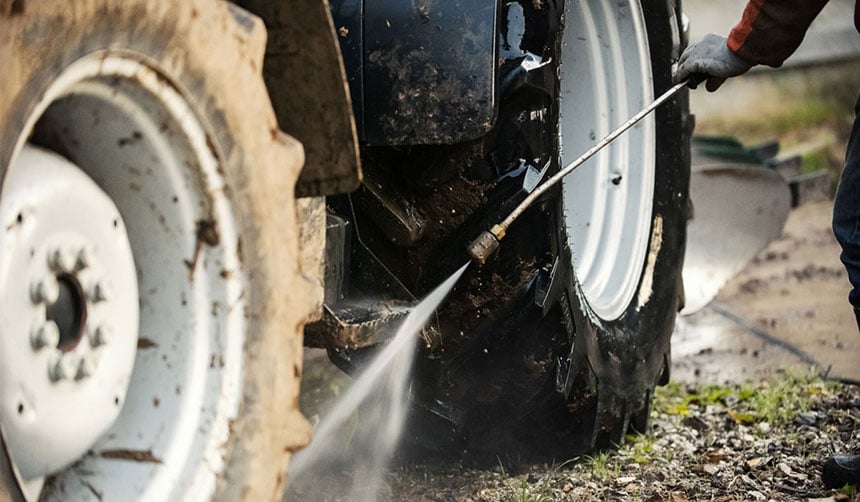 Systematic cleaning before storage of agricultural tyres
Systematic cleaning before storage of agricultural tyres
To summarise, here is the advice you need to keep your tyres in the best possible conditions:
- Clean the tyres before storing them to remove particles which could accelerate deterioration.
- Store the agricultural tyres away from light and variations in temperature (ideally inside).
- Keep the tyres away from chemical substances and sources of ozone.
- Avoid direct contact with cold and wet surfaces.
- Change the position of the tyres regularly (1/4 of a turn each month).
2. What are the best options for good tyre storage?
Tractor tyres require specific storage conditions to extend their lifespan and avoid having to invest in a new set of tyres following wear due to a lack of precautions taken.
There are different possibilities for storing agricultural tyres in the best possible conditions:
Storage on the tractor
If you don’t have time to take your wheels off the tractor even though it won’t be used for a long period, you should take the following precautions depending on the situation:
- Jack up the tractor
During prolonged parking, the weight of your machine will crush the tyres. To avoid damaging them, you can jack your tractor up and let out a little air so that the tyres do not have to bear too much weight.
- Offload as much weight as possible
If it’s a very heavy harvesting machine for example, jacking up the tractor is either practically impossible or too complex.
The best solution is therefore to offload as much of the non-fixed equipment as possible, while increasing pressure by around 0.5 bar.
With this solution you will need to move the tractor regularly, rotate the wheels one quarter of a turn at least once a month.
Storage on rims, removed from the tractor
Another storage option consists in removing the tyre on its rim for better conservation of the wheel’s overall structural resistance. This effectively allows you to take the weight of the agricultural machinery off the tyres. You have several options:
- Store the wheels flat or upright: in this case, it is advisable to avoid contact between the tyre and the ground to prevent any alteration of the rubber structure. You can use a pallet or any other special surface, given that the tyre must remain inflated to the usual working pressure.
- Store the tyres in piles: when the tyre is still on the rim, it keeps its resistance. Nevertheless, avoid over stacking the piles which puts the tyres at bottom under too much strain. The tyres must be placed on a perfectly flat surface and not be in contact with the floor.
CAUTION: Storage in piles for tyres on their rims
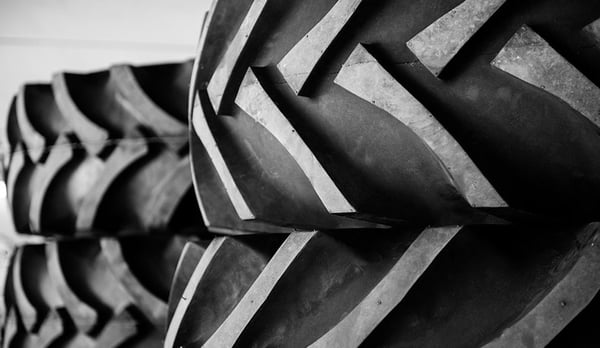
- Hang the tyres up: it is also possible to hang the tyres up by the centre of the rim. In this case, make sure that the tread does not come into contact with any parts of the device used to hang up the tyre.
Storage totally removed from the rim
As tyres are designed to be supple, they have less resistance once they have been removed from their rim.
If you opt for this storage solution, you must take the necessary precautions to prevent your tyres from losing their shape:
- Make sure the tyre is not touching the ground and avoid hanging it up: direct contact with the ground will affect the rubber or sidewall of the tyre. Use a pallet or any other device to store tyres without them touching the floor. Also avoid hanging up the tyre, because without the rim its structure lacks solidity, the bead and steel ply may deform under the weight of the tyre at the spot where the tyre is hung up, resulting in the need to replace it.
- Avoid stacking up tyres: without their rim, your agricultural tyres are less resistant. If you pile them up, those at the bottom of the pile will be crushed by the weight of the entire pile and will deform. This deformation is irreversible and your tyres will be unfit for use.
To store your tyres without rims in the best conditions, the most suitable solution is to stand them upright (vertically) on a special surface or pallet to avoid contact with the ground. If the storage period is long, don’t forget to rotate your tyres regularly one quarter of a turn.
3. How can you manage agricultural tyre handling operations for storage?
Tyre handling operations may be frequent, for repairs, mounting seasonal tyres or storing your tyres for winter. The weight and cumbersome size of agricultural tyres make handling operations complex and dangerous if you don’t have suitable equipment and if you don’t take certain precautions.
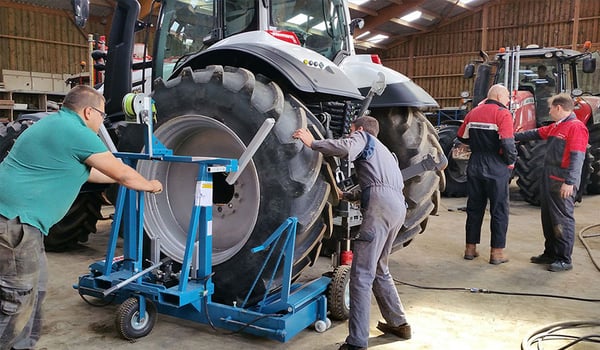 A wheel dolly is ideal for handling agricultural tyres
A wheel dolly is ideal for handling agricultural tyres
What equipment is necessary for good agricultural tyre handling?
Agricultural tyres are very heavy, not to mention the additional weight of the rims (between 110 and 350 kilos for rear drive wheels). It is therefore unwise to carry out handling operations without the right equipment.
Here is an indicative list of a few tools which make it easier to carry your agricultural tyres with or without their rims:
- A wheel dolly
- A forklift front loader
- A self-propelled truck with an arm
- A pallet truck
- A hoist
The essential precautions
Certain precautions must be taken when handling your agricultural tyres. Here is a detailed list of what not to do:
- Avoid hanging the tyres:
You have learned that agricultural tyres must not be hung up for storage, but you should also avoid them hanging during handling operations when using a hoist for example.
- Avoid transport with chains:
when you lift your tyres with a front loader for example, just use flat fabric slings rather than chains, ropes or a hook, to avoid damaging the steel plies situated at the level of the beads.
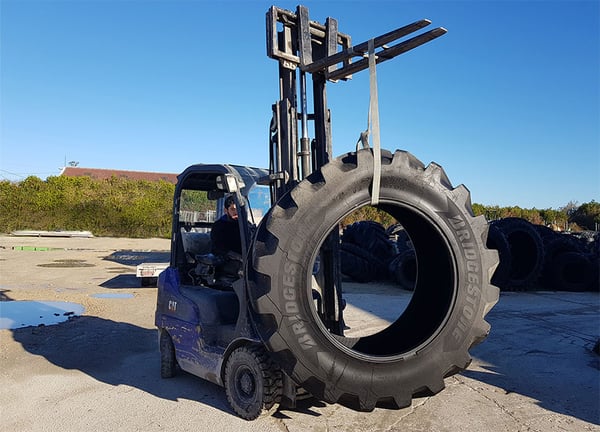
- Be careful not to lift the tyre with a forklift at the level of the bead:
the bead is one of the least resistant elements which may break under the pressure of a heavy load. When you lift the tyre using a forklift, the fork must only be placed under the outer circumference of the tyre, and not inserted into the beads.
Your tyres represent a certain investment and good management of this equipment allows you to keep them for longer.
A minimum amount of handling equipment and optimal storage during the winter are part of the good practices which ensure long life to your tyres and save you money.
For more information on tractor tyres
With Firestone, you have the guarantee of tractor tyres that deliver a real advantage, and that in choosing our brand, you can work worry-free.
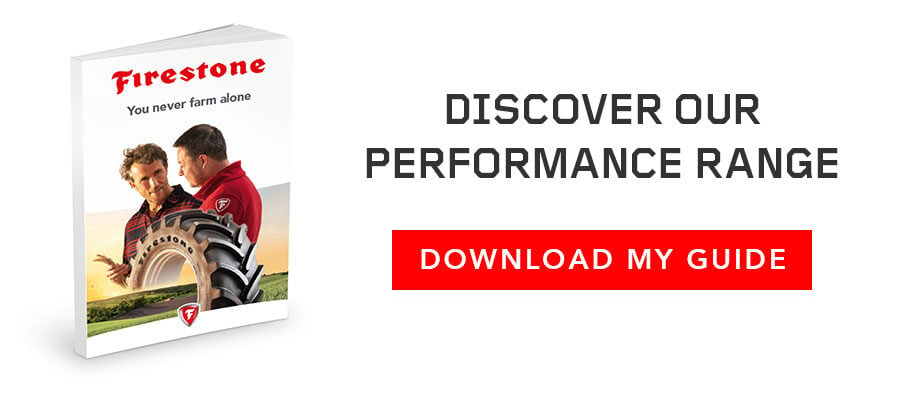
Most people who read this article have also read some of the following articles:
This information is intended only to make you aware of the technical and functional aspects of agricultural tires and their use. It does not allow you to make a judgment or a definitive conclusion on a given problem. Only your agricultural tire expert is able to make a technical assessment and take a final decision, case by case.